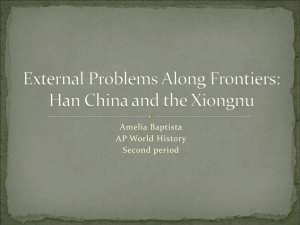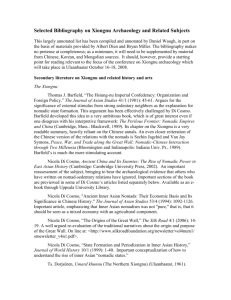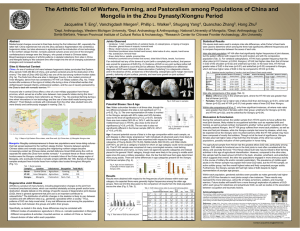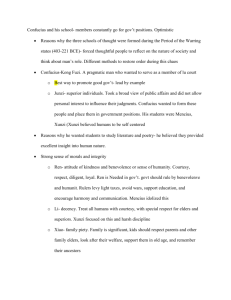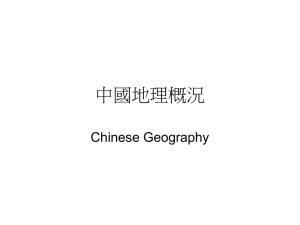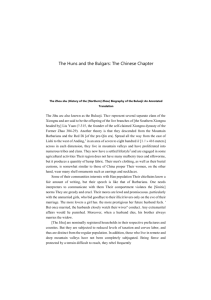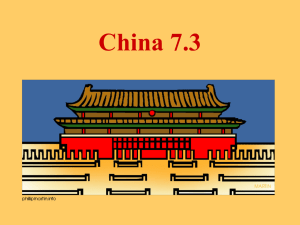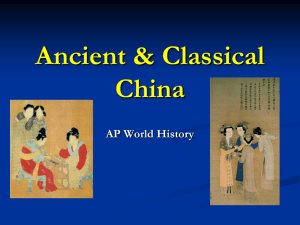The Xiongnu Essay - SMC WordPress
advertisement
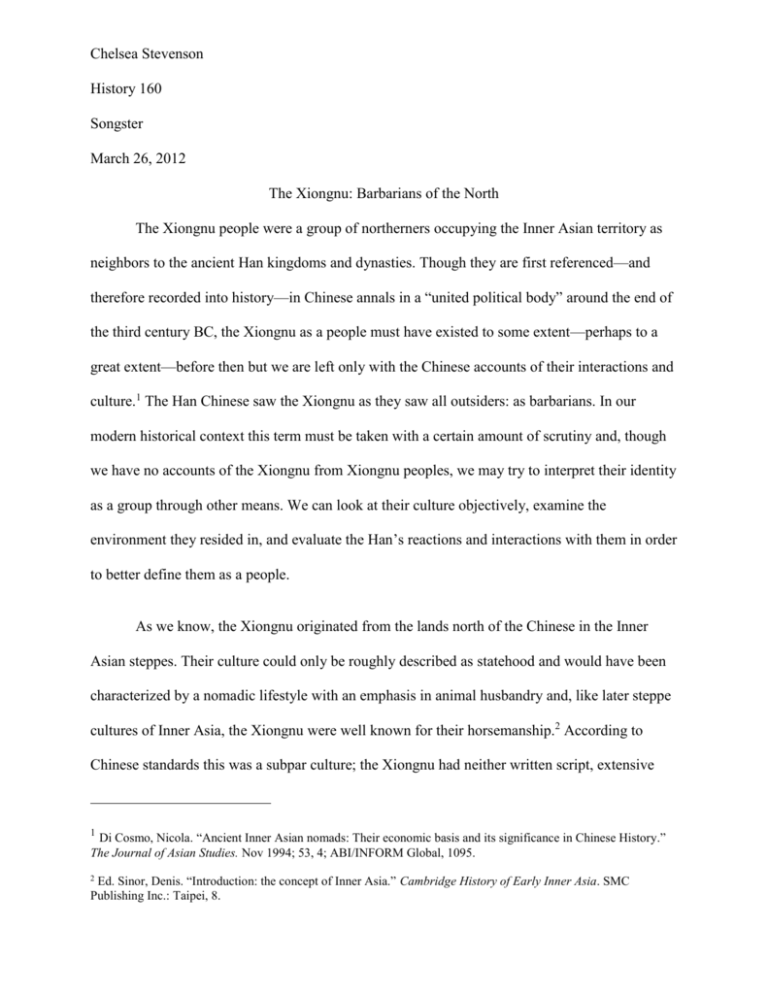
Chelsea Stevenson History 160 Songster March 26, 2012 The Xiongnu: Barbarians of the North The Xiongnu people were a group of northerners occupying the Inner Asian territory as neighbors to the ancient Han kingdoms and dynasties. Though they are first referenced—and therefore recorded into history—in Chinese annals in a “united political body” around the end of the third century BC, the Xiongnu as a people must have existed to some extent—perhaps to a great extent—before then but we are left only with the Chinese accounts of their interactions and culture.1 The Han Chinese saw the Xiongnu as they saw all outsiders: as barbarians. In our modern historical context this term must be taken with a certain amount of scrutiny and, though we have no accounts of the Xiongnu from Xiongnu peoples, we may try to interpret their identity as a group through other means. We can look at their culture objectively, examine the environment they resided in, and evaluate the Han’s reactions and interactions with them in order to better define them as a people. As we know, the Xiongnu originated from the lands north of the Chinese in the Inner Asian steppes. Their culture could only be roughly described as statehood and would have been characterized by a nomadic lifestyle with an emphasis in animal husbandry and, like later steppe cultures of Inner Asia, the Xiongnu were well known for their horsemanship.2 According to Chinese standards this was a subpar culture; the Xiongnu had neither written script, extensive 1 Di Cosmo, Nicola. “Ancient Inner Asian nomads: Their economic basis and its significance in Chinese History.” The Journal of Asian Studies. Nov 1994; 53, 4; ABI/INFORM Global, 1095. Ed. Sinor, Denis. “Introduction: the concept of Inner Asia.” Cambridge History of Early Inner Asia. SMC Publishing Inc.: Taipei, 8. 2 2 agriculture, cities, nor crafts—they did, however, share a language that was distinctly their own.3 Since we have no documentation of them beyond the earliest ones in the third century BC, there is no way of concretely describing or labeling them as a cohesive whole. In fact, before their ascent to influence and power under Motun it is not possible to place the moniker of nation on them at all. At best we might say that the Xiongnu at the time were a loose society of tribes who shared cultural practices as well as a common geography. Their geography, centered as it was in the steppe, was a great contributor to the development of their culture. Steppe biomes are ideal for herd animals and it was with domesticated herd species that the Xiongnu were prosperous with as a commodity. As read in the Cambridge History of Early Inner Asia: “The horse was the mainstay of steppe economy, the principal commodity produced, and in it lay the wealth of the nation.”4 This was also an environment which would have made widespread agriculture difficult and thus made the Chinese requirements for non-barbaric culture difficult and unlikely. Since they were a mostly nonsedentary society as well, being nomadic herders, crafting items that would require a stable base of operation—think blacksmithing, silk weaving, etc.—was just as improbable. To judge them by Han standards then is impractical; the Xiongnu adapted to their surroundings and their culture followed accordingly. If they are not barbarians then, how are we to define them? This answer may be more easily examined by discussing later developments among the Xiongnu peoples as they became a nation under the shan-yü Motun. 3 In-class lecture 2A Ed. Sinor, Denis. “Introduction: the concept of Inner Asia.” Cambridge History of Early Inner Asia. SMC Publishing Inc.: Taipei, 8. 4 3 Motun came to power after assassinating his father, the current shan-yü Tumen, in 209 BC.5 While it was Motun’s father who initially brought together the Xiongnu tribes, it was Motun who went on to challenge and successfully bring to heel the recently united Chin Dynasty of China. In the Ho-ch’in Treatiesof 198 BC, the now subservient China pledged tribute—luxury goods—and wives to the Xiongnu for peace.6 His descendants would go on to contribute more and more land and vassal territories to the Xiongnu name and it was at this point in history that we might best consider them a nation. The solidification of authority and sovereignty meant that the Xiongnu were no longer a scattered group of tribes but now a unified people. They became a militaristic state dependent upon their tributary pacts to receive the goods they did not produce themselves—namely agricultural and craft merchandises. While the Han may have merely seen them as barbarians of the north, we know that at least by that point the Xiongnu had developed their own sense of identity. They did not, for example, consider non-Han neighbors as equals or relatives of their cultural identity. The Tung-hu people , another northern group who were themselves called Eastern barbarians and hailed from parts of what would become Mongolia and Manchuria, were the rivals and neighbors of the Xiongnu—raiding them as the Xiongnu had raided the Han but, as with the Chinese, being defeated and made vassals under Motun.7 So we see that while the Xiongnu were considered northern barbarians, they saw themselves as their own unique group separate from other northern tribes or nations. Unlike the later northern Yü Ying-shih. “The Hsiung-nu.” Cambridge History of Early Inner Asia. Ed. Denis Sinor. SMC Publishing Inc.: Taipei, 120. 5 6 “The Hsiung-nu.” 122. 7 “The Hsiung-nu.” 125-6. 4 invaders of China, the Jurchens, the Xiongnu did not accept outsiders into their culture nor did they assert their culture upon others, as did the Mongols ruling in the Yuan Dynasty. What best conclusion we can come to then is this: the Xiongnu were a group of people who first began as a number of northern, nomadic tribes from the Inner Asian steppe who then reformed as an official nation of people under the guidance of Motun and the subsequent shanyü’s who followed up until their defeat by the Han during a decline of power in the century 100 BC. They were a people defined by the environment they came from and from the countries they interacted with—being raiders, traders, and invaders on the Han and surrounding neighbors. Though they may have been lumped together with other northern groups by the Han as barbarians, clearly the Xiongnu had their own definition of identity that separated them from all other northern tribes and powers. That they exerted force over and demanded tribute from northern peers like the Tung-hu demonstrates a lack of cultural camaraderie one might expect from a group of people who are purportedly the same—at least by Han standards. They were inclusive enough to define themselves as a group by anyone sharing their common cultural practices, language, and geography but exclusive enough to omit those considered by some to be their equals in non-civility. 5 Works Cited Di Cosmo, Nicola. “Ancient Inner Asian nomads: Their economic basis and its significance in Chinese History.”The Journal of Asian Studies. Nov 1994; 53, 4; ABI/INFORM Global. Ed. Sinor, Denis. “Introduction: the concept of Inner Asia.” Cambridge History of Early Inner Asia. SMC Publishing Inc.: Taipei. Songster, Edith. “Lecture 2A.” History 150. Saint Mary’s College of California, Moraga. February 2012. Lecture. Yü Ying-shih. “The Hsiung-nu.” Cambridge History of Early Inner Asia. Ed. Denis Sinor. SMC Publishing Inc.: Taipei.
